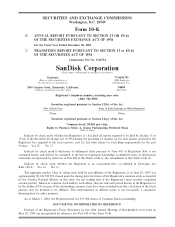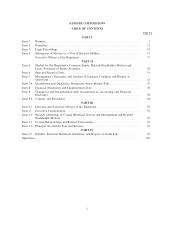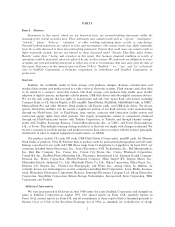SanDisk 2003 Annual Report Download - page 14
Download and view the complete annual report
Please find page 14 of the 2003 SanDisk annual report below. You can navigate through the pages in the report by either clicking on the pages listed below, or by using the keyword search tool below to find specific information within the annual report.In July 2000, we entered into a share purchase agreement to make a $75.0 million investment in Fab 2 at
Tower Semiconductor, Ltd., or Tower, in Israel. The investment has provided us with a guaranteed additional
wafer source for our controller components. The investment was payable in Ñve installments, each of which
was subject to the completion of certain milestones, four of which were paid in 2001 and 2002, with the Ñfth
and Ñnal milestone being paid in 2003. Fab 2 is currently producing controller wafers for some of our card
products. In November 2003, we agreed to further amend our foundry investment agreement, paid the Ñnal
portion of the Ñfth milestone payment and, among other things, agreed to defer the usage of the remainder of
our wafer credits available to us until Ñscal 2007. We began purchasing controller wafers from Tower in the
third quarter of 2003. See ""Management's Discussion and Analysis of Financial Condition and Results of
Operations Ì Factors That May AÅect Future Results Ì Risks Related to Our Investment in Tower
Semiconductor Ltd.''
We believe additional foundry capacity will be necessary to meet future demand for our products. Our
ability to increase our revenues and net income in future periods is dependent on establishing additional wafer
supply relationships and on receiving an uninterrupted supply of wafers from our manufacturing partners.
Our reliance on third-party wafer manufacturers involves several material risks, including shortages of
manufacturing capacity, reduced control over delivery schedules, quality assurance, production yields and
costs. This reliance could signiÑcantly harm our business, Ñnancial condition and results of operations. In
addition, as a result of our dependence on foreign wafer manufacturers, we are subject to the risks of
conducting business internationally, including political risks and exchange rate Öuctuations.
Assembly and Testing
We sort and test our wafers at Toshiba in Yokkaichi, Japan, and United Test Center, Inc. in Taiwan.
Substantially all of the tested wafers are then shipped to our third-party memory assembly subcontractors,
Chip PAC Ltd. in China, Silicon Precision Industries Co., Ltd. and Ficta Technology, Inc., both in Taiwan
and Sharp and Mitsui & Co., Ltd. both in Japan.
A substantial portion of our packaged memory Ñnal test, card assembly and card test is performed at
Silicon Precision Industries, United Test Center, Inc. and DataFab Systems, Inc. in Taiwan, and Celestica,
Inc., Chip PAC and Flextronics in China. In the foreseeable future, these subcontractors and others will
continue to assemble and test the vast majority of our products. We believe our use of subcontractors reduces
the cost of our operations and gives us access to increased production capacity. Any signiÑcant problems that
occur at our subcontractors, or their failure to perform at the level we expect, could result in a disruption of
production and a shortage of products to meet customer demand.
Our customers have demanding requirements for quality and reliability. To maximize quality and
reliability, we monitor electrical and inspection data from our wafer foundries and assembly and test
subcontractors. We monitor wafer foundry production for consistent overall quality, reliability, yield and defect
levels. Most of our major component suppliers and subcontractors are ISO 9001 or 9002 certiÑed.
Research and Development
We believe that our future success will continue to depend on the development and introduction of new
generations of Öash memory chips, controllers and products designed speciÑcally for the Öash data storage
market. In 2003, we completed our transition to 0.13 micron NAND Öash memory wafers. We are in the Ñnal
stages of developing the next generation 90 nanometer NAND Öash memory technology and anticipate
processing production wafers using this technology in the second half of 2004.
Our research and development expenses were $84.2 million, $63.2 million and $58.9 million, for the Ñscal
years 2003, 2002 and 2001, respectively. As of December 28, 2003, we had 283 full-time equivalent employees
engaged in research and development activities, primarily located in our Israel, Scotland, Japan and
Sunnyvale, California design centers. In Ñscal 2004, we expect to signiÑcantly increase our spending on
process and design research and development to support the development and introduction of new generations
of Öash data storage products.
10
























